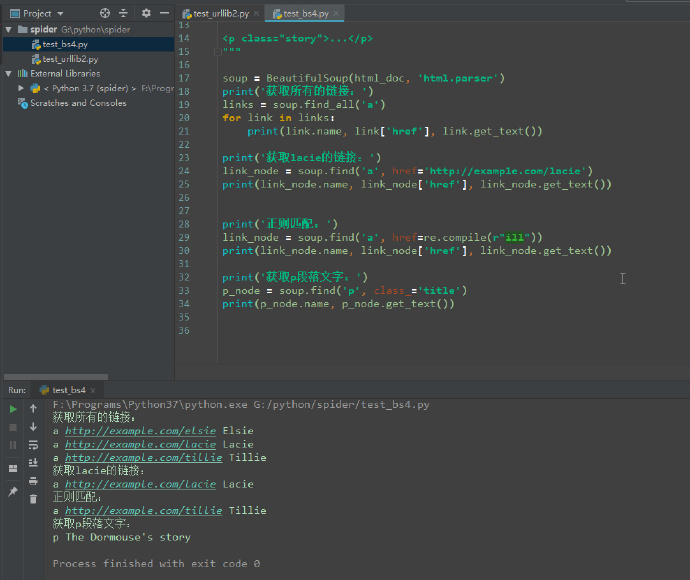Python简单爬虫
轻量级爬虫
- 不需要登录
- 静态网页 -- 数据不是异步加载
爬虫:一段自动抓取互联网信息的程序
URL管理器
管理对象
- 将要抓取的url
- 已经抓取过的url
作用
- 防止重复抓取
- 防止循环抓取
实现方式:
1、内存
python内存
待爬取URL集合:set()
已爬取URL集合:set()
2、关系型数据库
MySQL
数据表urls(url, is_crawled)
3、缓存数据库
redis
待爬取URL集合:set()
已爬取URL集合:set()
网页下载器
将获取到的网页下载到本地进行分析的工具
类型
1、urllib2
Python 官方基础 展模块
2、requests
第三方包,更强大
urllib2下载网页
1、方法一:最简单的方法
import urllib2
# 直接请求
response = urllib2.urlopen('http://www.baidu.com')
# 获取状态码,如果是200表示获取成功
print response.getcode()
# 读取内容
cont = response.read()
2、方法二:添加data、http header
import urllib2
# 创建Request对象
request urllib2.Request(url)
# 添加数据
request.add_data('a', '1')
# 添加http的header, 模拟Mozilla浏览器
response.add_header('User-Agent', 'Mozilla/5.0')
3、方法三:添加特殊情景的处理器
-
HTTPCookieProcessor:对于需要用户登录的网页 -
ProxyHandler:对于需要代理才能访问的网页 -
HTTPSHandler:对于https协议的网页 -
HTTPRedirectHandler:对于设置了自动跳转的网页
import urllib2, cookielib
# 创建cookie容器
cj = cookielib.CookieJar()
# 创建1个opener
opener = urllib2.build_opener(urllib2.HTTPCookieProcessor(cj))
# 给urllib2安装opener
urllib2.install_opener(opener)
# 使用带有cookie的urllib2访问网页
response = urllib2.urlopen("http://www.baidu.com")
实例代码
# coding:utf8
import urllib2, cookielib
url = "http://www.baidu.com"
print("一种方法:")
response1 = urllib2.urlopen(url)
print(response1.getcode())
print(len(response1.read()))
print('第二种方法:')
request = urllib2.Request(url)
request.add_header("user-agent", 'Mozilla/5.0')
response1 = urllib2.urlopen(url)
print(response1.getcode())
print(len(response1.read()))
print('第三种方法:')
cj = cookielib.CookieJar()
opener = urllib2.build_opener(urllib2.HTTPCookieProcessor(cj))
urllib2.install_opener(opener)
response3 = urllib2.urlopen(request)
print(response3.getcode())
print(cj)
print(response3.read())
注:以上是Python2的写法,以下是Python3的写法
# coding:utf8
import urllib.request
import http.cookiejar
url = "http://www.baidu.com"
print("一种方法:")
response1 = urllib.request.urlopen(url)
print(response1.getcode())
print(len(response1.read()))
print('第二种方法:')
request = urllib.request.Request(url)
request.add_header("user-agent", 'Mozilla/5.0')
response1 = urllib.request.urlopen(url)
print(response1.getcode())
print(len(response1.read()))
print('第三种方法:')
cj = http.cookiejar.CookieJar()
opener = urllib.request.build_opener(urllib.request.HTTPCookieProcessor(cj))
urllib.request.install_opener(opener)
response3 = urllib.request.urlopen(request)
print(response3.getcode())
print(cj)
print(response3.read())
网页解析器
解析网页,从网页中提取有价值数据的工具
网页解析器(BeautifulSoup)
类型
1、正则表达式(模糊匹配)
2、html.parser(结构化解析)
3、Beautiful Soup(结构化解析)
4、lxml(结构化解析)
结构化解析-DOM(Document Object Model)树
安装并使用 Beautiful Soup4
1、安装
pip install beautifulsoup4
2、使用
- 创建BeautifulSoup对象
- 搜索节点(按节点名称、属性、文字)
- find_all
- find
- 访问节点
- 名称
- 属性
- 文字
(1)创建Beautiful Soup对象
from bs4 import BeautifulSoup
# 根据HTML网页字符串创建BeautifulSoup对象
soup = BeautifulSoup(
html_doc, # HTML文档字符串
'html.parser', # HTML解析器
from_encoding='utf8' # HTML文档的编码
)
(2)搜索节点(find_all,find)
# 方法:find_all(name, attrs, string)
# 查找所有标签为a的节点
soup.find_all('a')
# 查找所有标签为a,链接符合/view/123.html形式的节点
soup.find_all('a', href='/view/123.htm')
soup.find_all('a', href=re.compile(r'/view/\d+\.htm'))
# 查找所有标签为div,class为abs,文字为Python的节点
soup.find_all('div', class_='abc', string='Python')
- 用class_作为查询类属性的变量名,因为class本身是python的关键字,所以需要加一个下划线来区别
(3)访问节点信息
# 得到节点:<a href="1.html">Python</a>
# 获取查找到的节点的标签名称
node.name
# 获取查找到的a节点的href属性
node['href']
# 获取查找到的a节点的链接文字
node.get_text()
3、实例
# coding:utf8
from bs4 import BeautifulSoup, re
html_doc = """
<html><head><title>The Dormouse's story</title></head>
<body>
<p class="title"><b>The Dormouse's story</b></p>
<p class="story">Once upon a time there were three little sisters; and their names were
<a href="http://example.com/elsie" class="sister" id="link1">Elsie</a>,
<a href="http://example.com/lacie" class="sister" id="link2">Lacie</a> and
<a href="http://example.com/tillie" class="sister" id="link3">Tillie</a>;
and they lived at the bottom of a well.</p>
<p class="story">...</p>
"""
soup = BeautifulSoup(html_doc, 'html.parser')
print('获取所有的链接:')
links = soup.find_all('a')
for link in links:
print(link.name, link['href'], link.get_text())
print('获取lacie的链接:')
link_node = soup.find('a', href='http://example.com/lacie')
print(link_node.name, link_node['href'], link_node.get_text())
print('正则匹配:')
link_node = soup.find('a', href=re.compile(r"ill"))
print(link_node.name, link_node['href'], link_node.get_text())
print('获取p段落文字:')
p_node = soup.find('p', class_='title')
print(p_node.name, p_node.get_text())
执行后效果:

开发爬虫
分析目标
- URL格式
- 数据格式
- 网页编码
1、目标: 百度百科Python词条相关词条网页 -- 标题和简介
2、入口页
https://baike.baidu.com/item/Python/407313
3、URL格式:
- 词条页面URL:
/item/****
4、数据格式:
- 标题:
<dd class="lemmaWgt-lemmaTitle-title"><h1>...</h1></dd>
- 简介:
<div class="lemma-summary" label-module="lemmaSummary">...</div
5、页面编码:UTF-8
项目目录结构

调度主程序
# coding:utf8
from baike_spider import url_manager, html_downloader, html_parser, html_outputer
class SpiderMain(object):
def __init__(self):
# url管理器
self.urls = url_manager.UrlManager()
# 下载器
self.downloader = html_downloader.HtmlDownloader()
# 解析器
self.parser = html_parser.HtmlParser()
# 输出器
self.outputer = html_outputer.HtmlOutputer()
# 爬虫的调度程序
def craw(self, root_url):
count = 1
self.urls.add_new_url(root_url)
while self.urls.has_new_url():
try:
if count == 1000:
break
new_url = self.urls.get_new_url()
print('craw %d : %s' % (count, new_url))
html_cont = self.downloader.download(new_url)
new_urls, new_data = self.parser.parse(new_url, html_cont)
self.urls.add_new_urls(new_urls)
self.outputer.collect_data(new_data)
count = count + 1
except:
print('craw failed')
self.outputer.output_html()
if __name__ == "__main__":
root_url = "https://baike.baidu.com/item/Python/407313"
obj_spider = SpiderMain()
obj_spider.craw(root_url)
URL管理器
# coding:utf8
class UrlManager(object):
def __init__(self):
self.new_urls = set()
self.old_urls = set()
def add_new_url(self, url):
if url is None:
return
if url not in self.new_urls and url not in self.old_urls:
self.new_urls.add(url)
def add_new_urls(self, urls):
if urls is None or len(urls) == 0:
return
for url in urls:
self.add_new_url(url)
def has_new_url(self):
return len(self.new_urls) != 0
def get_new_url(self):
new_url = self.new_urls.pop()
self.old_urls.add(new_url)
return new_url
网页下载器
# coding:utf8
import urllib.request
class HtmlDownloader(object):
def download(self, url):
if url is None:
return None
# request = urllib.request.Request(url)
# request.add_header("user-agent", 'Mozilla/5.0')
response = urllib.request.urlopen(url)
if response.getcode() != 200:
return None
return response.read()
网页解析器
# coding:utf8
from bs4 import BeautifulSoup, re
from urllib.parse import urljoin
class HtmlParser(object):
def _get_new_urls(self, page_url, soup):
new_urls = set()
links = soup.find_all('a', href=re.compile(r"/item/"))
for link in links:
new_url = link['href']
new_full_url = urljoin(page_url, new_url)
new_urls.add(new_full_url)
return new_urls
def _get_new_data(self, page_url, soup):
res_data = {}
res_data['url'] = page_url
title_node = soup.find('dd', class_='lemmaWgt-lemmaTitle-title').find('h1')
res_data['title'] = title_node.get_text()
summary_node = soup.find('div', class_='lemma-summary')
res_data['summary'] = summary_node.get_text()
return res_data
def parse(self, page_url, html_cont):
if page_url is None or html_cont is None:
return
soup = BeautifulSoup(html_cont, 'html.parser')
new_urls = self._get_new_urls(page_url, soup)
new_data = self._get_new_data(page_url, soup)
return new_urls, new_data
网页输出器
# coding:utf8
class HtmlOutputer(object):
def __init__(self):
self.datas = []
def collect_data(self, data):
if data is None:
return
self.datas.append(data)
def output_html(self):
fout = open('output.html', 'w')
fout.write('<html>')
fout.write('<body>')
fout.write('<table>')
for data in self.datas:
fout.write('<tr>')
fout.write('<td>%s</td>' % data['url'])
fout.write('<td>%s</td>' % data['title'].encode('utf-8'))
fout.write('<td>%s</td>' % data['summary'].encode('utf-8'))
fout.write('</tr>')
fout.write('</table>')
fout.write('</body>')
fout.write('</html>')
fout.close()
高级爬虫:
- 登录
- 验证码
- Ajax
- 服务器防爬虫
- 多线程
- 分布式
学习资料:慕课网-Python开发简单爬虫
每天积累一点点



 浙公网安备 33010602011771号
浙公网安备 33010602011771号